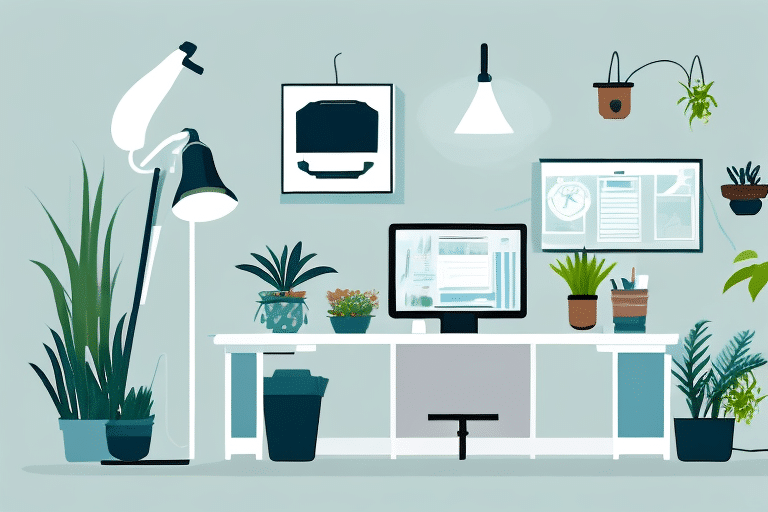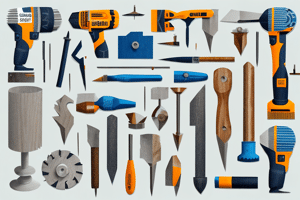UPDATED: March 17, 2024
Working from home has become increasingly popular in recent years, and having a well-designed and efficient home office is essential for productivity and work-life balance. In this article, we will explore the importance of creating an efficient workspace, the essential elements of a home office, technology options, designing for comfort, and maintaining your home office. We will also address common challenges and provide tips for a more efficient home office setup.
Understanding the Importance of an Efficient Home Office
Having a well-organized and functional home office has a significant impact on productivity. A clutter-free workspace promotes focus and minimizes distractions, allowing you to work more efficiently. Research has shown that a well-designed work environment can increase productivity by up to 20%. Additionally, having a designated workspace helps separate work life from personal life, reducing stress and enhancing work-life balance.
Creating an efficient home office involves more than just organizing your desk and supplies. It's also about incorporating elements that inspire creativity and motivation. Consider adding personal touches like motivational quotes, plants, or artwork to make your workspace more inviting and conducive to productivity. Natural light and ergonomic furniture can also play a significant role in enhancing your comfort and overall well-being while working from home.
The Impact on Productivity
When your home office is thoughtfully organized, you can easily find everything you need, eliminating time wasted searching for documents or supplies. A tidy workspace also promotes mental clarity and helps you stay on task. Studies have revealed that individuals who work in well-organized environments are 42% more productive and 33% more accurate in their work.
Furthermore, incorporating technology and tools that streamline your workflow can significantly boost your productivity. Utilizing project management software, communication tools, and ergonomic accessories can help you work more efficiently and effectively. By embracing technology that complements your work style, you can optimize your home office setup for peak performance.
Balancing Work and Personal Life
Having a dedicated home office allows you to establish clear boundaries between work and personal life. By physically separating your workspace from the living area, you can better focus during work hours and fully disconnect when the day is done. This separation is crucial for maintaining a healthy work-life balance, leading to reduced stress and improved overall well-being.
Additionally, creating a daily routine and setting specific work hours can further enhance your work-life balance. By establishing a schedule that includes breaks, exercise, and time for personal activities, you can prevent burnout and maintain a sense of fulfillment both professionally and personally. Incorporating mindfulness practices such as meditation or stretching exercises into your workday can also help reduce stress and improve your mental well-being.
Essential Elements of a Home Office
Creating an efficient home office starts with selecting the right furniture, setting up proper lighting, and organizing your workspace effectively. A well-designed home office not only enhances productivity but also promotes a healthy work environment.
Choosing the Right Furniture
Investing in ergonomic furniture is key to maximizing comfort and productivity. A comfortable chair with proper lumbar support and adjustable height is essential for maintaining good posture and reducing the risk of developing back pain. Consider a sit-stand desk that allows you to alternate between sitting and standing, promoting better circulation and reducing sedentary behavior. In addition to functionality, choose furniture pieces that complement your home decor to create a cohesive and inspiring workspace.
Importance of Lighting
Good lighting is crucial for reducing eye strain and fatigue. Natural light is ideal, as it boosts mood and energy levels. Position your desk near a window if possible to benefit from natural sunlight throughout the day. To supplement natural light, incorporate task lighting such as a desk lamp with adjustable brightness settings to provide adequate illumination for detailed work tasks. Consider the color temperature of your light sources; cool white light is energizing, while warm white light is calming.
Organizing Your Workspace
A well-organized workspace maximizes efficiency and minimizes distractions. Utilize a combination of storage solutions to keep your workspace clutter-free and optimized for productivity. Consider implementing a digital filing system to reduce paper clutter and streamline document management. Invest in cable management tools such as cable clips and sleeves to keep cords tidy and prevent tangling. Personalize your workspace with inspiring decor elements like motivational quotes, plants, or artwork to create a space that reflects your personality and boosts creativity.
Technology for Your Home Office
Selecting the right technology is crucial for a smooth and efficient work-from-home experience. Creating a productive workspace involves more than just a desk and a chair; it requires careful consideration of the tools and technology that will support your daily tasks and responsibilities.
When setting up your home office, think beyond just the basics. Consider incorporating elements like proper lighting to reduce eye strain, noise-canceling headphones to minimize distractions, and even some greenery to enhance the overall ambiance and air quality of your workspace.
Selecting the Right Computer and Accessories
Your computer is the heart of your home office, so invest in a reliable and fast machine that meets your work requirements. Whether you opt for a desktop, laptop, or all-in-one PC, prioritize features like processing power, storage capacity, and display quality to ensure seamless multitasking and efficient workflow. Additionally, consider additional accessories such as a wireless keyboard and ergonomic mouse to enhance comfort and productivity, reducing the risk of repetitive strain injuries during long work hours.
Furthermore, don't overlook the importance of data security and backup solutions. Implementing regular data backups and utilizing antivirus software can safeguard your work files and sensitive information from potential cyber threats, providing you with peace of mind and ensuring business continuity.
Internet and Communication Tools
Utilize tools like video conferencing software, project management apps, and cloud storage services to stay connected and collaborate effectively with colleagues or clients. Platforms such as Zoom, Slack, Trello, and Google Drive offer seamless communication channels, task organization, and document sharing capabilities, fostering teamwork and boosting productivity in a virtual work environment.
Moreover, prioritize network security measures to protect your online activities and confidential data. Implementing a virtual private network (VPN) and enabling two-factor authentication can enhance the privacy and integrity of your online communications, especially when handling sensitive information or conducting business transactions remotely.
Designing Your Home Office for Comfort
A comfortable workspace promotes productivity and reduces physical strain.
When designing your home office for comfort, it's essential to consider not only the practical aspects but also the aesthetic elements that can enhance your overall well-being. By creating a space that is both functional and visually appealing, you can cultivate a work environment that supports your productivity and creativity.
Ergonomics in the Home Office
Ergonomics focuses on creating a workspace that supports your body's natural alignment and minimizes discomfort. Position your chair and desk at the correct height to ensure that your feet are flat on the floor, your wrists are straight, and your eyes are level with the top of your monitor. Invest in an adjustable standing desk or a monitor arm to alternate between sitting and standing positions throughout the day.
Furthermore, consider incorporating ergonomic accessories such as a supportive chair cushion, a keyboard tray to maintain a neutral wrist position, and proper lighting to reduce eye strain. These small adjustments can make a significant difference in your comfort level and long-term health.
Creating a Relaxing Atmosphere
The ambiance of your home office can significantly impact your mood and focus. Incorporate elements that help you relax and stay motivated, such as plants, inspiring artwork, or a soothing color scheme. Personalize your workspace with items that bring you joy and make you feel comfortable.
In addition to visual elements, consider adding elements of comfort such as a cozy throw blanket, a scented candle, or a small indoor fountain to create a calming atmosphere. By incorporating these elements, you can transform your home office into a sanctuary that promotes relaxation and focus, allowing you to work more effectively and comfortably.
Maintaining Your Home Office
To ensure your home office remains efficient and conducive to productivity, regular cleaning and updating are essential. A well-maintained home office not only boosts your work efficiency but also creates a positive and inspiring environment for your daily tasks.
When it comes to creating a productive workspace, regular cleaning and de-cluttering play a crucial role. Set aside dedicated time each week to clean and declutter your home office. Remove any unnecessary items, dust surfaces, and wipe down your computer screen and keyboard. Consider organizing your desk with storage solutions like trays and bins to keep essential items within reach but neatly arranged. Keeping your workspace clean and organized will not only enhance the aesthetics of your office but also help maintain focus and prevent distractions.
Regular Cleaning and De-cluttering
Set aside dedicated time each week to clean and declutter your home office. Remove any unnecessary items, dust surfaces, and wipe down your computer screen and keyboard. Keeping your workspace clean and organized will help maintain focus and prevent distractions. Additionally, consider incorporating indoor plants into your office space to improve air quality and add a touch of greenery, which has been shown to boost mood and productivity.
Updating Your Equipment and Furniture
Technology advances quickly, so periodically assess your equipment and furniture to ensure they meet your current needs. Consider upgrading outdated devices to improve efficiency and take advantage of new features. Remember to dispose of old equipment responsibly by recycling or donating. Investing in an ergonomic chair and adjustable desk can significantly enhance your comfort and reduce the risk of strain or injury from prolonged sitting. Furthermore, personalize your workspace with inspiring artwork or motivational quotes to create a space that energizes and motivates you throughout the workday.
Overcoming Common Home Office Challenges
Working from home presents unique challenges that can hinder productivity. Here are some strategies to overcome common issues.
Creating an efficient and productive home office environment is essential for remote work success. In addition to minimizing distractions, it's important to design a workspace that is comfortable and conducive to focus. Consider investing in ergonomic furniture to support your posture and reduce physical strain during long work hours. Personalize your workspace with inspiring decor or plants to boost your mood and motivation.
Dealing with Distractions
Identify common distractions in your home office and develop strategies to minimize their impact. Create a schedule that includes dedicated work time and breaks. Use noise-cancelling headphones or play focus-enhancing music to drown out background noise. Communicate with family members or roommates about your work hours and set clear boundaries.
Furthermore, implementing visual cues, such as a "Do Not Disturb" sign on your door, can signal to others when you need uninterrupted focus time. Organizing your work tasks and setting daily goals can also help you stay on track and avoid getting sidetracked by non-essential activities.
Managing Work Hours and Breaks
Establish a routine and set specific work hours to maintain structure and prevent overworking. Take regular breaks to rejuvenate your mind and avoid burnout. Use productivity techniques, such as the Pomodoro Technique, where you work for a set amount of time and then take short breaks. Remember to step away from your desk during breaks to stretch and move your body.
Moreover, incorporating physical activity into your daily routine can enhance your overall well-being and productivity. Consider scheduling short exercise sessions or walks during breaks to boost your energy levels and improve focus. Maintaining a healthy work-life balance is crucial for long-term sustainability and mental health while working from home.
Tips for a More Efficient Home Office
Here are some additional tips to further enhance efficiency in your home office.
Time Management Strategies
Create a to-do list or use productivity apps to prioritize tasks and track progress. Break larger tasks into smaller, manageable chunks to prevent overwhelm. Set specific goals and deadlines to keep yourself accountable and motivated.
Utilizing Space Effectively
If your home office space is limited, make the most of vertical space by using wall-mounted shelves or storage units. Consider multi-purpose furniture, such as a desk with built-in storage. Utilize organizational tools to maximize space and minimize clutter.
Investing in Quality Supplies
Using high-quality office supplies can significantly improve efficiency and comfort. Invest in a comfortable keyboard and mouse, ergonomic desk accessories, and noise-cancelling headphones. Quality supplies will enhance your overall experience and make work tasks more enjoyable.
But there's more to creating an efficient home office than just time management and space utilization. Let's delve into a few additional aspects that can take your productivity to the next level.
Ergonomic Considerations
One often overlooked aspect of a home office is ergonomics. It's important to have a workspace that is designed with your physical well-being in mind. Invest in an adjustable chair that provides proper lumbar support and promotes good posture. Consider a height-adjustable desk that allows you to switch between sitting and standing positions throughout the day. Additionally, position your computer monitor at eye level to reduce strain on your neck and eyes.
Optimizing Lighting
The right lighting can make a world of difference in your home office. Natural light is ideal, as it helps improve mood, focus, and overall well-being. Position your desk near a window to take advantage of natural light. If natural light is limited, invest in a good desk lamp with adjustable brightness levels to reduce eye strain. Avoid harsh overhead lighting that can cause glare on your computer screen.
By paying attention to ergonomics and optimizing lighting, you can create a home office that not only enhances efficiency but also promotes your physical and mental health.





